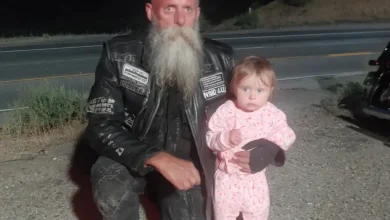
“The Surprising Way I Reacted When a Child Kept Hitting My Seat on a Flight”
My body ached from cramped seats, rushing through terminals, and long hours of meetings. My mind was saturated with spreadsheets, deadlines, and the constant ping of notifications that never seemed to stop.
As soon as I buckled in, I leaned back, closed my eyes, and let myself imagine being home—my own bed, a warm shower, and a rare moment of peace.
The soft hum of the engines and the gentle vibration of the aircraft against the clouds felt, for a moment, almost comforting.
But that calm was soon interrupted. A small, energetic voice came from the seat behind me—a voice bright and curious, with the unstoppable rhythm of childhood.
I opened my eyes slightly and saw a little boy, probably seven or eight, bouncing slightly in his seat. He was talking rapidly to his mother, asking question after question, his words tumbling out in a mix of excitement and wonder.
“Mom, why do planes fly so high? Are those clouds soft? Can I eat the whole snack pack?” He continued, unrelenting, his questions spilling over one another, leaving barely a pause for the adult world to respond.
Normally, I might have smiled at his curiosity, even felt a touch of nostalgic amusement, but today, my exhaustion made every sound feel magnified, each syllable echoing like a drumbeat in my skull.
And then the tapping began. At first, it was soft, almost accidental—light, intermittent thumps against my seatback. But it grew steadily louder, rhythmic and insistent.
Each tap seemed to vibrate straight into my shoulders, jarring me out of the brief calm I had just claimed. I could hear his mother whispering, trying to calm him, and the flight attendant passing by with a polite reminder that he needed to settle.
For a moment, it worked. But as soon as they walked away, the tapping resumed, louder than ever.
Frustration began to rise inside me, a tight, uncomfortable coil. My mind raced through possible reactions—turning around and scolding him, asking the flight attendant to intervene, even considering giving a sharp, impatient glare.
But then I looked at him. Really looked. He was innocent, his eyes wide, his small hands restless, his curiosity unrestrained.
He wasn’t trying to annoy me; he was simply a child, trapped in a seat for hours, with boundless energy and a mind that refused to slow down.
I exhaled slowly, consciously deciding to shift my perspective. What if I responded not with frustration, but with understanding? What if I tried something unexpected?
With that thought, I turned around—not with anger, but with gentle curiosity. “Hey, buddy,” I said softly, “do you like drawing?”
Instantly, his eyes lit up. His face brightened, a smile breaking across it like sunlight through clouds. I reached into my bag and pulled out a small notebook and pen that I usually kept for jotting work notes.
“Here,” I said, handing them to him, “draw me something from the clouds.”
His mother’s reaction was a mixture of surprise and relief. She whispered a quiet “thank you,” her gratitude palpable even in her hushed tone.
The boy nodded eagerly, gripping the pen with the intensity of someone who had been given a small gift of freedom. Slowly, the bouncing stopped.
The chatter faded. Instead, I could hear the soft scratching of the pen against paper, the gentle sound almost meditative. His focus was absolute, as though he had discovered a new world inside that notebook.
For the next few hours, every so often, he would hold up a drawing for me to see—a tiny airplane soaring amidst fluffy clouds, a radiant sun shining down, or stick figures laughing mid-air.
I would nod, give a thumbs-up, and he would beam proudly before returning to his work. Each drawing carried a little spark of his personality, his joy, and his boundless imagination.
The tapping had completely stopped, replaced by this quiet, shared activity that brought a sense of calm to both of us.
As the flight continued, I found myself observing more than just the boy. I noticed the subtle way his mother relaxed as she watched him create.
I noticed other passengers glancing over with curiosity, some smiling at the transformation of an annoying situation into something unexpectedly beautiful.
I noticed the way the sunlight shifted through the plane’s windows, glinting off the little pencil lines on his pages. And I noticed, most of all, how a small act of patience and kindness could completely change the energy of a moment.
When the plane finally touched down, the boy handed me one of his pages—a drawing of a smiling airplane flying through puffy clouds, the sun shining above it, and tiny stick figures waving from the windows.
“For you,” he said shyly, his small voice barely above a whisper, yet full of sincerity.
I smiled, deeply touched by the gesture. That single piece of paper, drawn with simple pencil lines and raw creativity, carried more warmth than any conversation or polite smile could.
As I stood to leave the plane, clutching the drawing, I realized something essential: patience and empathy often accomplish what frustration never can.
A little understanding had turned what could have been a stressful, irritating flight into a moment of quiet connection, human warmth, and shared joy.
Later, reflecting on the experience, I realized that the boy hadn’t merely stopped tapping my seat—he had reminded me of something vital.
He had reminded me that kindness can transform annoyance into connection, that patience can transform frustration into peace, and that even in fleeting moments with strangers, we can create lasting meaning.
That simple flight became a lesson in empathy, perspective, and the quiet power of small, thoughtful gestures.
Sometimes, it takes a child’s curiosity—and a willingness to pause and respond with kindness—to turn chaos into calm, irritation into inspiration, and strangers into companions, if only for a brief flight across the sky.
That day, I was reminded that even in moments of exhaustion, the simplest human interactions can leave the deepest impressions, and that the smallest acts of patience often carry the largest rewards.




